Looking to target and tone your latissimus dorsi muscles without expensive gym equipment? Resistance bands provide a simple, affordable way to strengthen your back and lats right at home.
With a resistance band, you can sculpt and define your lat muscles without the need for bulky machines or heavy dumbbells.
A strong latissimus dorsi muscle is important for improving posture, preventing back pain, and mastering pull-ups or chin-ups.
In this post, we will share some effective resistance band exercises for your lat that you can do anywhere, anytime along with a workout plan.
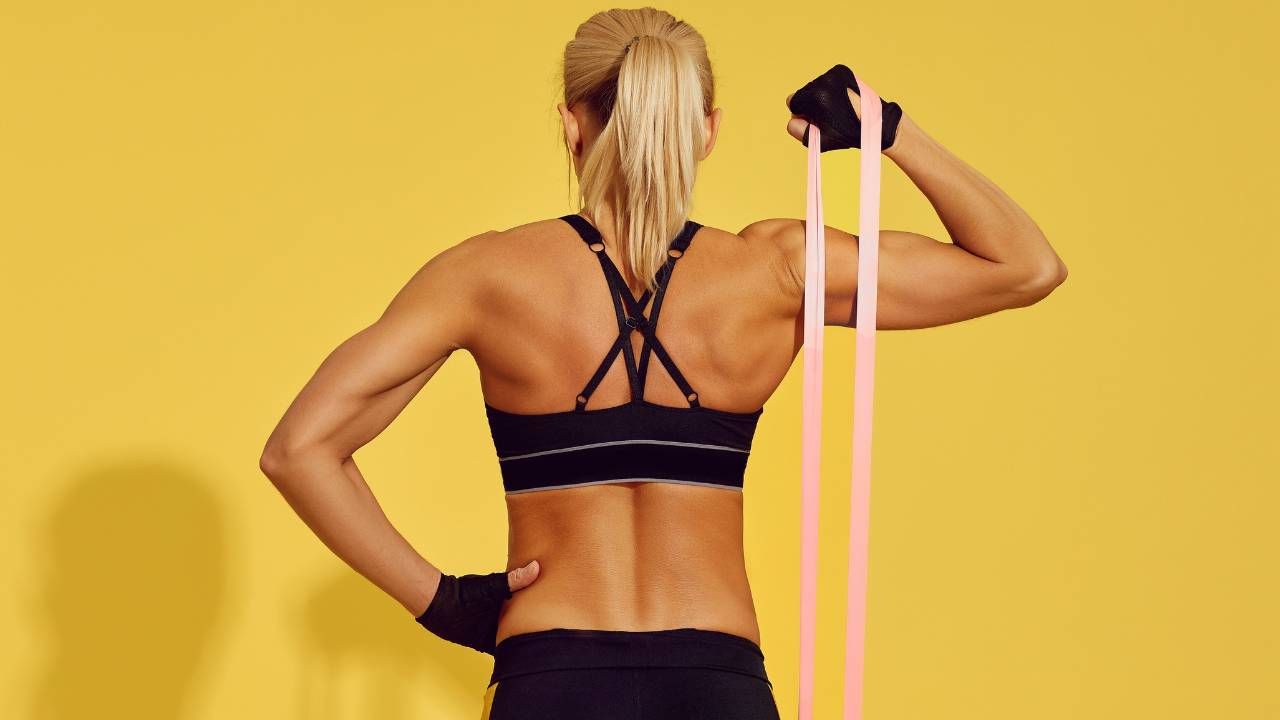
- Anatomy Of The Lats
- 5 Best Lat Exercises With Resistance Band At Home
- 1. Resistance Bands Lats Pulldown
- 2. Resistance Band Bent Over Rows
- 3. Resistance Band Row
- 4. Band Straight Arm Pulldown
- 5. Band Pullover
- At Home Resistance Band Lat Workout Plans
- Band Back Workout Routine For Beginner
- Benefits Of Resistance Bands Lat Workout
- 1. Low-Impact
- 2. Convenient And Cost-Effective
- 3. Build Muscle And Strength
- 4. Improved Flexibility And Rehabilitation
- 5. Fun And Creative Workouts
- Conclusion
Anatomy Of The Lats
The latissimus dorsi, also known as the lats, is a large, triangular muscle that covers the back of the torso. The largest muscle in the human body, it is important for many different movements, such as rowing, pulling, and climbing.
The lats originate from the spine, the ribs, and the iliac crest. They insert into the intertubercular groove of the humerus, which is located on the front of the upper arm bone.
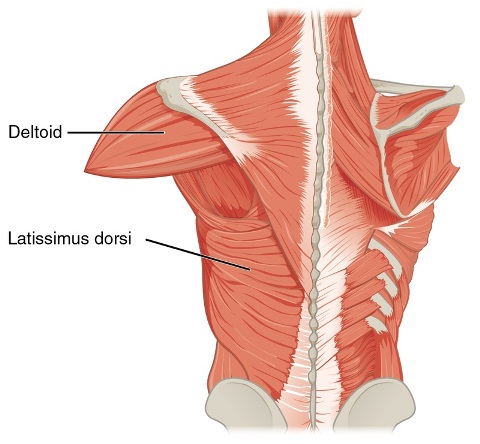
The lats have a number of different functions, including:
- Adduction: Bringing the arm towards the body
- Extension: Straightening the arm at the elbow joint
- Internal rotation: Turning the palm of the hand inward
- Depression: Lowering the arm
- Stabilization: Helping to keep the shoulder joint stable
The lats are also important for good posture. They help to keep the shoulders down and back, and they prevent the spine from hunching forward.
Want to take your gains to the next level? Discover your daily calorie needs with our free TDEE calculator
5 Best Lat Exercises With Resistance Band At Home
Band lat exercises have the highest activation, and they will allow you to perform pulldowns, rows, and reverse fly exercises that target every muscle fiber in your back.
Here are the best exercises that you can do with a band to build a bigger and wider back: These exercises will hit your lat from all of the angle.
1. Resistance Bands Lats Pulldown
The resistance band lats pulldown can be done anywhere, so it’s a good option for home workouts or while travelling.
It is a compound exercise that engages multiple muscle groups of the back, specifically the latissimus dorsi (lats) and teres major.
There are some variations of the resistance band pull down to add to your back workout:
- Close-grip pulldown: Hold the resistance band with a closer grip. This will target the inner lats more.
- Wide-grip lat pulldown: Wide grip will target the outer lats more.
- One-arm pulldown: Work on each part separately and make your weaker side as strong as your stronger side.

How To Do Band Lat Pulldown
- Attach the resistance band to a sturdy anchor point above your head, such as a door frame.
- Stand facing the anchor point and grasp the resistance band with an overhand grip.
- Step back to create tension in the band. Engage your core, slightly lean back.
- Pull the band down towards your chest. Squeeze your shoulder blades together at the end of the movement.
- Slowly release the tension and return to the starting position.
- Repeat for the desired number of repetitions.
Tips
- Do 3-4 sets of 10-12 repetitions of resistance band lat pulldowns.
- Focus on pulling with your back muscles rather than relying on your arms.
- Make sure you control the movement both on the way down and up.
2. Resistance Band Bent Over Rows
Resistance band bent over rows are a popular lat exercise that targets the muscles of the upper back, including the rhomboids, trapezius, and latissimus dorsi. They are a compound exercise that also works your arms, and core muscle.
This exercise targets the muscles responsible for proper posture, such as the rhomboids and trapezius. It can also reduce the risk of rounded shoulders.
Other variations of band bent over rows to build bigger and stronger back at home.
- Single-Arm Resistance Band Rows: The back muscles are trained unilaterally by this variation. Better Mind Muscle Connection.
- Underhand Grip Resistance Band Rows: Switching to an underhand grip targets your biceps and lower lats.
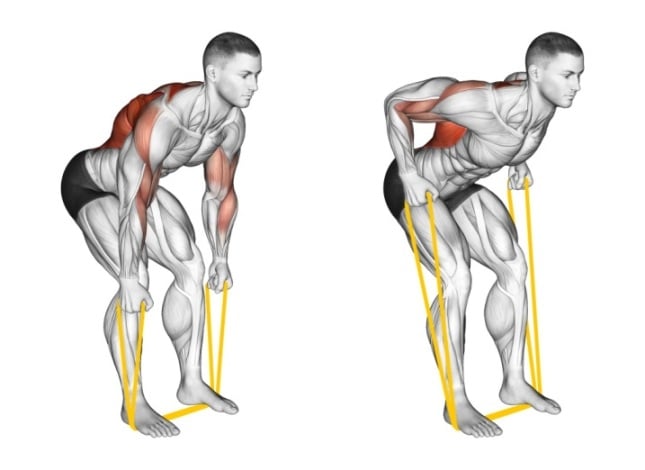
How To Do
- Stand on the center of the resistance band with your feet hip-width apart.
- Hinge forward at the hips while keeping your back straight. Lower your torso until it is parallel to the ground.
- Hold the band with your palms facing inwards. Allow your arms to hang below your shoulders.
- Engage your core to stabilize your spine. Pull your elbows back and squeeze your shoulder blades together.
- Pause when your elbows are at your sides. Focus on contracting the lats through the whole movement.
- Slowly straighten your arms to return to the starting position.
- Repeat for the desired number of reps.
Tips
- Avoid rounding or arching your back. Maintain a neutral spine.
- Focus on pulling with your back muscles rather than relying on your arms.
- Your elbows should be close to your body as you pull.
3. Resistance Band Row
The resistance band row is a highly effective lat exercise that can be done anywhere with just a band.
This exercise primarily targets the muscles of the upper back, including the rhomboids, trapezius, and rear deltoids, as well as the biceps and core.
Other ways to build bigger and stronger lats at home with band over rows.
- Seated resistance band row: It is a great option for beginners or those with limited mobility. It is also an excellent choice for targeting the upper lats.
- Standing resistance band row: It is a more challenging variation that targets the entire back muscles.
- Kneeling resistance band row: This variation involves a half-kneeling or full-kneeling position. It can help isolate the upper back muscles by reducing assistance from the lower body.
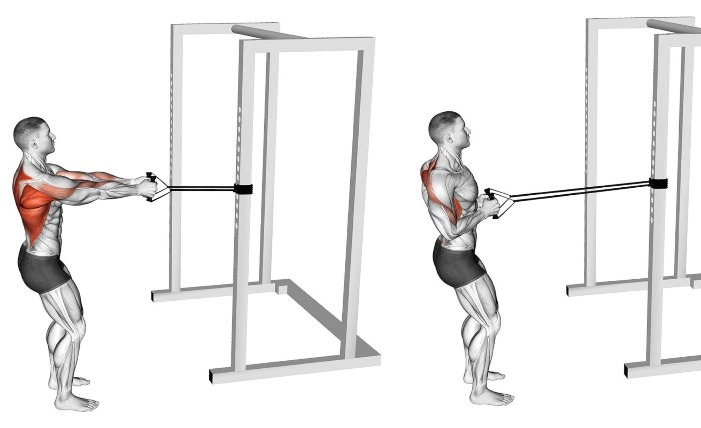
How to Do Standing Band Rows
- Stand with your feet shoulder-width apart. Hold a resistance band handle in each hand.
- Take a step back to create tension in the band.
- Keep your knees bent and hinge your hips slightly. Keep your back straight and core engaged.
- Pull your elbows back and push them past your torso. You should squeeze your shoulder blades together at the peak of your contraction.
- Pause for a moment, then slowly straighten your arms to return to the starting position.
Tips
- Keep your chest lifted and avoid rounding your shoulders as you row.
- Focus on using your back muscles rather than momentum to pull the handles.
- Breathe out as you pull back, and breathe in as you return to the starting position.
- Keep your legs stationary and avoid excessive swaying.
4. Band Straight Arm Pulldown
It is a variation of the classic lat pulldown exercise and is performed standing with the elbows locked out the entire time.
The straight-arm pulldown is ideal for lifters who can’t feel their lats working on traditional pulldown exercises.
It is a good choice for beginners because it is easy to perform.

How To Do Band Straight Arm Pulldown
- Secure the resistance band overhead or at a high anchor point.
- If you don’t have an anchor point, you can hold the band stretched overhead with both hands.
- Hold the band ends or handles with both hands, palms facing down. Stand tall with feet shoulder-width apart.
- Extend your arms straight up overhead, ensuring there’s tension in the band.
- Keep your arms straight and pull the band ends down to your thighs.
- Pause at the bottom of the movement, then slowly lower the band back to the starting position.
Tips
- Avoid excessive arching in the lower back as you pull down.
- Keep your arms straight during the pull-down. Bending the elbows can shift the focus away from the lats.
- You can adjust the resistance by gripping the band closer together (increased resistance) or wider apart (reduced resistance).
5. Band Pullover
The lying band pullover is a great alternative to the standard pullover. It is the best band exercise to build a strong rib cage and build the serratus anterior muscle to build a complete chest and lat.
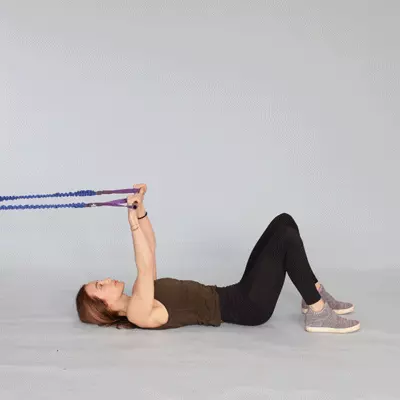
How To Do Band Pullover
- Anchor the resistance band securely at a low point. Lie down on a flat bench or on the floor.
- Hold the handles of the band in each hand and bend your elbows slightly.
- Move your arms backward, following a semi-circular path.
- Slowly bring the handles back together over your chest to return to the starting position.
- Repeat for 10-12 reps.
Tips
- Ensure that your back remains firmly in contact with the ground.
- Avoid locking out your elbows; maintain a soft bend.
- Focus on stretching and contracting the lat instead of using momentum.
At Home Resistance Band Lat Workout Plans
This workout has many band exercises that work all the muscles in your back and make you stronger overall.
This workout plan is a starting point that can be adjusted based on individual fitness levels and goals.
Band Back Workout Routine For Beginner
| Exercise | Sets | Reps | Rest |
|---|---|---|---|
| Standing Band Row | 3-4 | 8-10 | 60-90 seconds |
| Band lat Pulldown | 3-4 | 8 | 60-90 seconds |
| Band Pullover | 4 | 8-10 | 60-90 seconds |
Benefits Of Resistance Bands Lat Workout
1. Low-Impact
Resistance bands are a low-impact form of exercise, which means they put less stress on your joints than other forms of exercise, such as running or jumping. It is an excellent option for people with joint pain or injuries
2. Convenient And Cost-Effective
Resistance bands are cheaper than regular gym equipment, which makes fitness more accessible to more people.
Resistance bands are light and easy to carry, so they’re great for home workouts, travel, or even outdoor training. No need for heavy equipment or dedicated spaces – bands allow for efficient workouts anytime, anywhere.
3. Build Muscle And Strength
Resistance bands are easy to use, even for beginners. You can do many different exercises with resistance bands to build muscle and strength.
This study found that resistance band training was effective in increasing muscle strength and size in older adults.
4. Improved Flexibility And Rehabilitation
Bands are commonly used in physical therapy for injury recovery, assisting in gentle strength building. Stretching with resistance bands helps to improve flexibility and range of motion.
Bands have a smooth resistance curve, which makes them good for rehabilitation and people with joint problems.
5. Fun And Creative Workouts
Resistance bands can be used to target a variety of muscle groups, making them a versatile tool for exercise.
Bands can be looped, anchored, or used in different ways, making workouts engaging and enjoyable. Bands can be combined with free weight or bodyweight exercises for added intensity and variety.
Conclusion
Resistance band exercises are a great way to build a strong and well-defined lat. They are a versatile and affordable option that can be done at home or at the gym. You can do a lot of different exercises with resistance bands, so you can find ones that work for you.
When doing resistance band exercises, make sure to use a band that is hard but not too hard. You should be able to do 8-12 reps of each exercise with good form.
Know More Resistance Band Exercises
- Best Resistance Band Chest Exercises
- Resistance Band Back Workouts
- Best Resistance Band Shoulder Exercises
- Resistance Band Trap Exercises
- Best Resistance Band Tricep Exercises
References
- Lopes JSS, Machado AF, Micheletti JK, de Almeida AC, Cavina AP, Pastre CM. Effects of training with elastic resistance versus conventional resistance on muscular strength: A systematic review and meta-analysis [published correction appears in SAGE Open Med. 2020 Sep 9;8:2050312120961220]. SAGE Open Med. 2019;7:2050312119831116. Published 2019 Feb 19. doi:10.1177/2050312119831116.
- Bergquist R, Iversen V, Mork P, Fimland M. Muscle Activity in Upper-Body Single-Joint Resistance Exercises with Elastic Resistance Bands vs. Free Weights. Journal of Human Kinetics. 2018;61(1): 5-13. https://doi.org/10.1515/hukin-2017-0137
- Jeno SH, Varacallo M. Anatomy, Back, Latissimus Dorsi. [Updated 2022 Apr 5]. In: StatPearls [Internet]. Treasure Island (FL): StatPearls Publishing; 2022 Jan-. Available from: https://www.ncbi.nlm.nih.gov/books/NBK448120/

Manish brings over 10 years of hands-on experience in weight lifting and fat loss to fitness coaching. He specializes in gym-based training and has a lot of knowledge about exercise, lifting technique, biomechanics, and more.
Through “Fit Life Regime,” he generously shares the insights he’s gained over a decade in the field. His goal is to equip others with the knowledge to start their own fitness journey.
